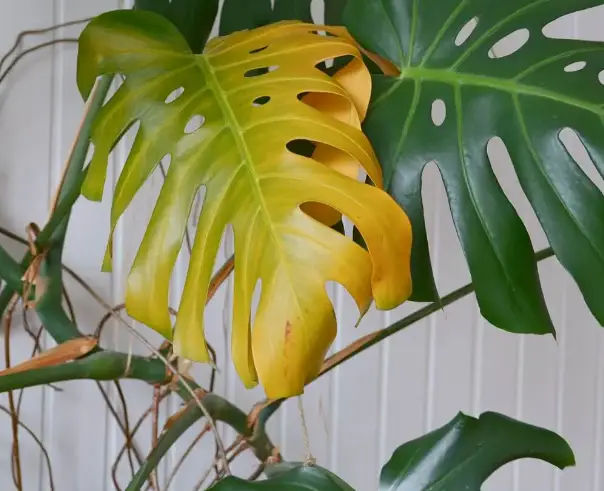7 Signs Of Underwatered Monstera With Solutions
The Monstera is known for its large, perforated leaves that resemble Swiss cheese and is a very famous plant choice for indoor plants among gardeners because of its ability to purify the air and its beauty.
The Monstera plant also known as the Swiss cheese plant is a tropical delight beauty that is known for its enormous, gleaming green leaves. It is not difficult to raise as it requires a little focus and it can flourish in various circumstances and even in low-light conditions also.
Due to all this stuff, it’s a more likable plant among gardeners, it can even grow in different temperatures and even in low light conditions.

Monstera Plant Overwatered signs are majorly droopy stems, wilting, leaf curling and curling inward, other reasons are the dull appearance of leaves, stems, crispy dry leaf edges, slow growth, sunken leaves, leaf drop, or loss of leaves.
we can see more of them in tropical rainforests of Central and South America, These leaves grow beautifully, are gradient green, and can reach up to two feet in height.
The plant’s stems are thick and strong, and it has aerial roots that help in absorbing moisture and nutrients from the air.
from my personal experience of raising them, you may come across a few problems raising them, one of the few general issues we face is underwatering.
Underwatering is a common issue for Monstera plants and it’s important to recognize the signs to prevent damaging the plant.
These are following some of the common signs of underwatered Monstera that indicate the plant needs water
1. Droopy stems
it’s very much important to understand that droopy monstera stems can indicate a lacking of water. It’s a sign that the plant is not getting enough water and is becoming dehydrated. When the soil becomes dry,
water is not available to the roots, and the stems start to droop. This makes strong and stiff upright stems look soft and pliable.
If the droopy stems are not addressed and taken care of, the plant may become further dehydrated, which leads plants to show other signs of underwatering, It’s important to water the plant promptly to prevent further damage.
2. Wilting
Wilting is a common sign that plants are not getting enough water for their generation process. When a plant doesn’t receive enough water, its leaves start to look wilted, like flowers that have been left without water for a too long period.
This is because the plants are not getting enough moisture to support their growth and health.
When the soil is dry, the plant cannot absorb water, and the leaves start looking dull. This is a sign that the plant requires more water, and it’s important to water them as soon as possible.
If your Monstera plant and you notice that its leaves are wilting, You can check the soil by inserting your finger about an inch into the soil to see if it’s dry, then give them a good watering, and make sure to water it thoroughly so that the soil is evenly moistured.
So, if you have a wilting Monstera, no worries! Just give it a watering session, and it will be fine in no time.
3. Leaf curling or curling inward
it is a sign that your Monstera plant is not receiving enough water. When the soil is dry, the plant can’t absorb enough water to support its growth, causing the leaves to curl inward or become misshapen. This is a way for the plant to conserve moisture and protect itself from becoming further stressed.
Imagine your Monstera plant is like a person who is feeling very thirsty. When it’s not getting enough water, it starts to feel dehydrated and wilts, just like a person might become fatigued when they are dehydrated. This is why the leaves start to curl and become misshapen.
To help your Monstera plant, it’s important to give it a good drink of water as soon as you notice that the leaves are curling. You can check the soil by inserting your finger about an inch into the soil to see if it’s dry. If it is, give the plant a good drink, making sure to water it thoroughly so that the soil is evenly moist.
Remember, it’s important to water your Monstera regularly to keep it healthy and happy. With proper care, your Monstera will thrive and its beautiful, lush foliage will bring joy to your home for many years to come.
4. A dull appearance or lack of shine on the leaves
it can be a sign that the Monstera plant is not receiving enough water or nutrients. The leaves should be brighter and shinner in appearance, with a vibrant green color. When the plant is not getting enough moisture or nutrients, the leaves can become dull and lose their shine.
it’s important to make sure it is getting enough water and nutrients. You can check the soil by inserting your finger about an inch into the soil to see if it’s dry. If it is, give the plant a good drink, making sure to water it thoroughly so that the soil is evenly moist.
You can also consider giving your Monstera plant a balanced by using organic fertilizer to nurture the nutrients it needs. Make sure to follow the instructions on the fertilizer package, as over-fertilizing can also be harmful to the plant.
By taking care of your Monstera, you can help it to stay healthy and vibrant, and its beautiful leaves will shine with health for years to come.
5. Crispy or dry leaf edges
Crispy or dry leaf edges on a Monstera plant can be a sign that the plants are not getting enough water or is being exposed to dry air more often. When the leaves don’t receive enough moisture, the edges can become dry and crispy, which can lead to further damage if not addressed.
To help your Monstera plant, it’s important to give it a good taste of water as soon as you notice the crispy or dry leaf edges. make sure to water it thoroughly so that the soil is evenly moist.
It’s also important to make sure the plant is not being exposed to dry air, which can make them to dehydration.
Consider misting the leaves with water droplets or even placing a humidifier nearby to increase the air humidity in the air around the plant’s environment.
By providing proper care, you can retrieve your Monstera plant to recover and keep them healthy and with much vibrance.
With time, your Monstera will revive, and you’ll be joyful to see them
6. Slow growth and Brown, sunken spots on leaves
Brown, sunken spots on the leaves of a Monstera plant and its growth rate is slow, this can be a sign of a fungal or bacterial disease, or it could be caused by over-watering or even underwatering. These spots can further spread and cause further damage to the plant if not addressed.
Just like how a cut or scrape can get infected, the brown, sunken spots on your Monstera’s leaves are an indication that something is not right with your Monstera plant.
now it’s time to address the issue. If you think the plant may have fungal or bacterial infections, just remove the affected leaves and treat the plant with a fungicide or bactericide.
By taking care of your Monstera, you can help it to stay healthy for a long time.
7. Leaf drop or loss of leaves
sometimes losing leaves may be caused by watering, its plant’s metabolism drops leaves when they need water, so this could also be a sign of underwatering, so find out and address them sooner.
Final Thoughts:
so the conclusion is that these are some of the common signs of an underwatered Monstera plant. These symptoms or signs indicate that the plant is not receiving enough water and may be suffering from dehydration. By providing proper care, regular watering of the plants, and adjusting their environment, you can help ensure that your Monstera remains healthy and vibrant for many years to come.
